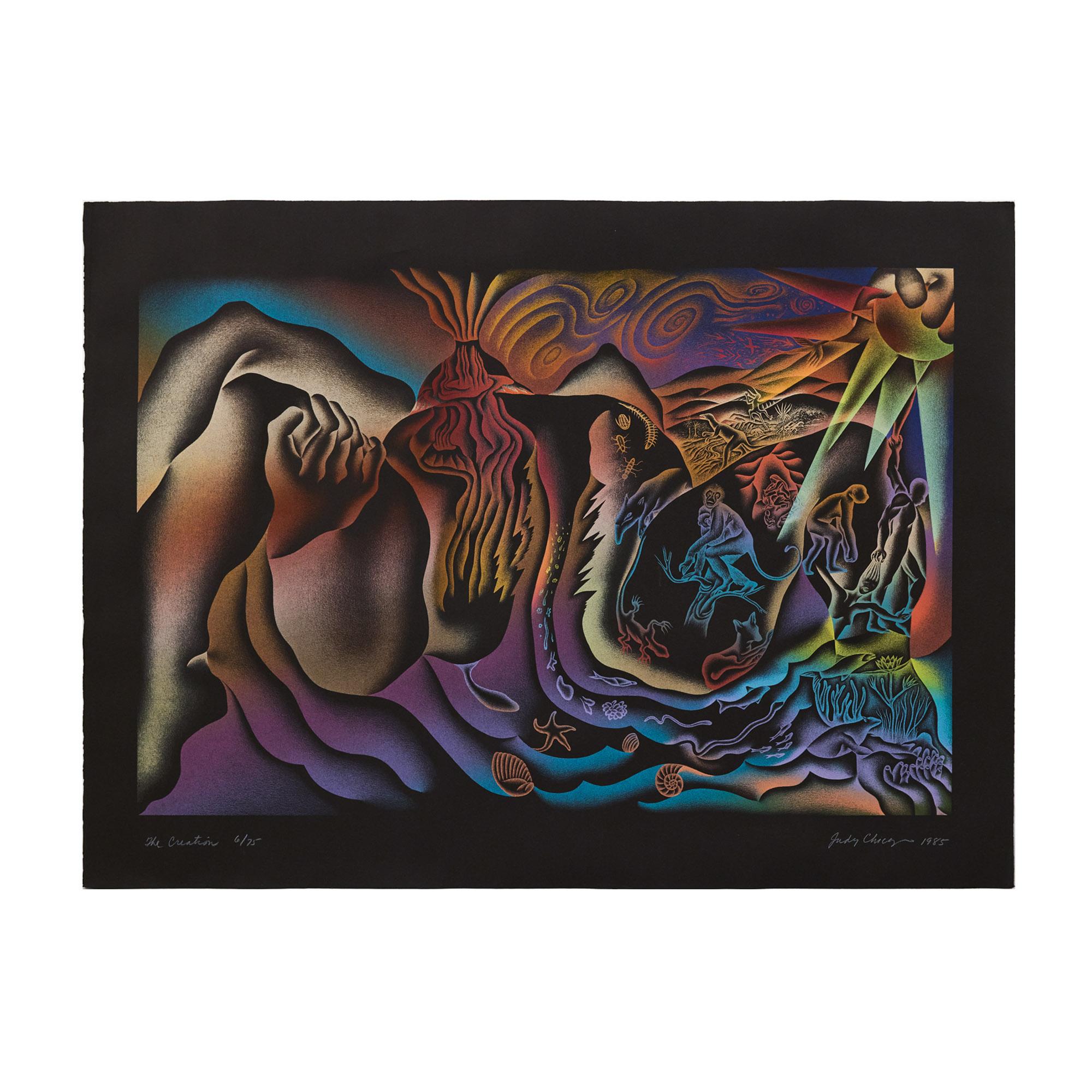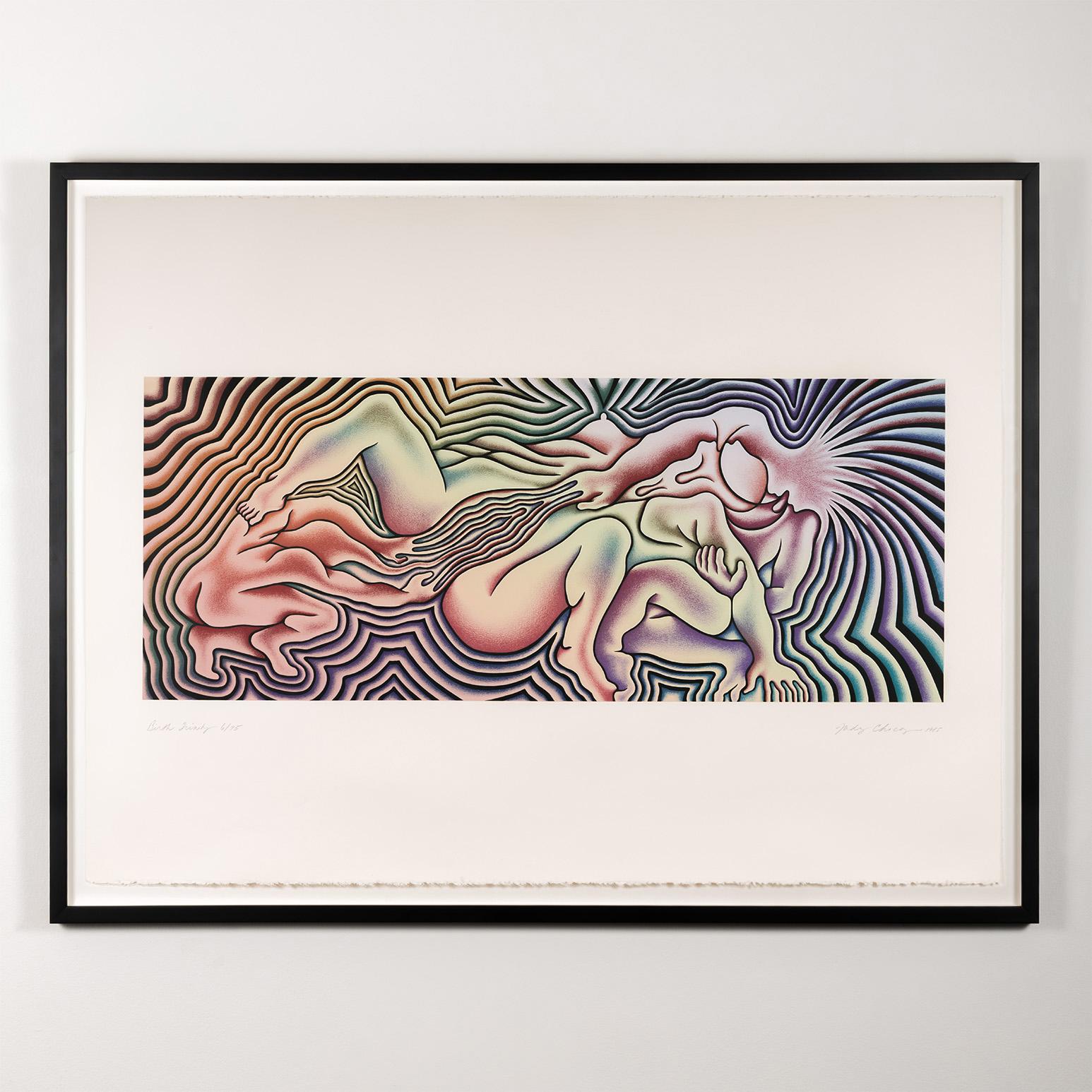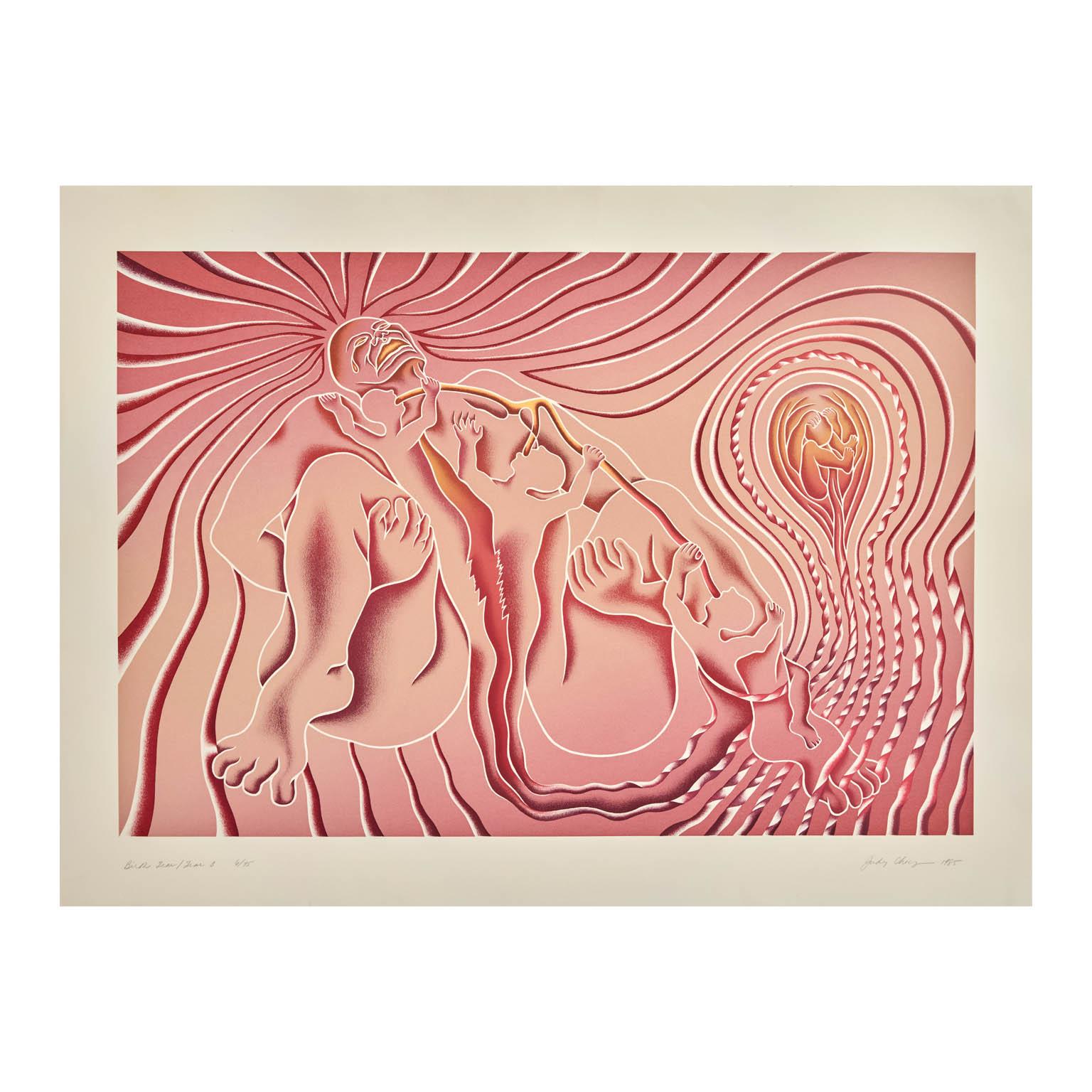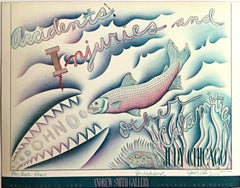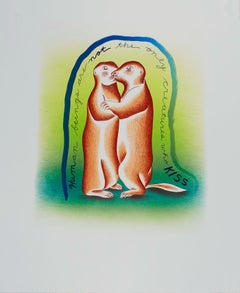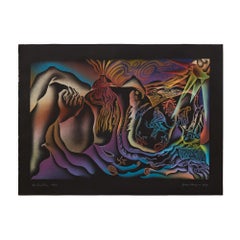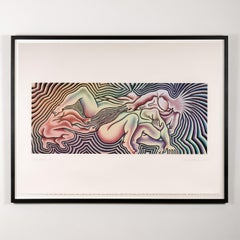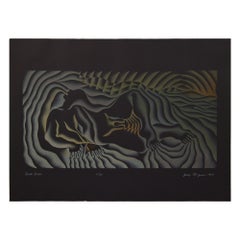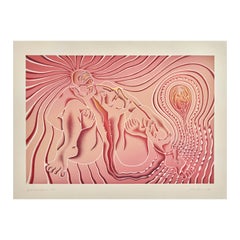Items Similar to Driving the World to Destruction (iconic silkscreen, signed, #35/50) Wood Frame
Want more images or videos?
Request additional images or videos from the seller
1 of 10
Judy ChicagoDriving the World to Destruction (iconic silkscreen, signed, #35/50) Wood Frame1988
1988
$10,000
£7,603.40
€8,759.22
CA$14,217.37
A$15,451.84
CHF 8,165.69
MX$186,933.88
NOK 101,697.88
SEK 96,059.97
DKK 65,397.48
About the Item
Judy Chicago
Driving the World to Destruction, 1988
Silkscreen on wove paper
Pencil signed, titled, dated and numbered 35/50 on the front
Included with this work is an elegant hand made wood frame.
Measurements:
Frame included: Floated and framed in a museum quality wood frame with UV plexiglass
35.25" (vertical) x 46" (horizontal) x 2" (width)
Artwork:
30 × 40 1/4 inches
"Who is driving the world to destruction?", if you were to ask feminist artist Judy Chicago, the answer is toxic masculinity. In 2023-4 she was the subject of a sprawling career retrospective at the New Museum in New York, aptly titled Herstory. One of the highlights of the New Museum show is a monumental painting entitled Driving the World to Destruction. The present silkscreen is based upon the original painting shown at the New Museum. (We have included an installation photo of the painting exhibited at the New Museum, for reference only, courtesy of the New York Times.)
This iconic silkscreen is based upon Judy Chicago's eponymous 1985 painting. In 1982-87, Chicago investigated the toxic construct of masculinity. While traveling through Italy in 1982, Chicago was inspired by the style and scale of Renaissance painting, though she noted that, of course, it served to heroize the male as the harbinger of reason and virtue. Images of heroic men would of course return to more overtly evil ends with fascist neoclassicism. To combat this, Chicago renders the male body in the statuesque Renaissance style and oftentimes with the same horizontality of the frieze to different ends: to expose the destructive and petulant nature of masculinity. Jonathan D. Katz describes the series as in line with deconstructionist/conceptual art, “In appropriating a tradition of heroic masculinity in order to dissect and undercut a tradition of heroic masculinity, Chicago thus makes irony her handmaiden, the very irony that was, at the time these works were first shown, increasingly in evidence as a means of resistance across the art world at large.”
In the Me-Too era, Chicago, one of the very first self-identified feminist artists, is now having her day - one of the hottest artists in the press and art fairs. Her works, about male power, are eerily prescient. The artist herself made this observation during the 2018 Brett Kavanaugh Supreme Court hearings when she posted on Instagram: "It's really sad to see my paintings come true decades after they were created" - referenced in this Artsy editorial below: "Judy Chicago's Work Reveals Toxic Masculinity." This work is elegantly floated and framed in a gorgeous wood frame with museum conservation standards.
Judy Chicago Biography
Born Judy Cohen in Chicago, Illinois, in 1939, Chicago attended the Art Institute of Chicago and the University of California, Los Angeles. Chicago’s early work was Minimalist, and she was part of the landmark Primary Structures exhibition in 1966 at The Jewish Museum in New York. She turned to feminist content in the late 1960s. At this time she changed her last name to Chicago, the location of her birth.
Believing in the need for a feminist pedagogy for female art students, Chicago began the first Feminist Art Program at California State University, Fresno, in 1970. The following year, with artist Miriam Schapiro, she co-founded the Feminist Art Program at California Institute of the Arts, Valencia. Womanhouse (1972), a collaborative installation the two artists created with their students, transformed an abandoned building into a house representative of women’s experiences.
Chicago is perhaps best known for her iconic The Dinner Party (1974–1979), which celebrates women’s history through place settings designed for 39 important women. The monumental, collaborative project incorporates traditional women’s crafts such as embroidery, needlepoint, and ceramics.
Chicago’s work has continued to address themes from women’s lives with The Birth Project (1980–1985) and The Holocaust Project (1985–1993). She is a prolific lecturer and writer, and she has taught at Duke and Indiana Universities and the University of North Carolina at Chapel Hill. Her numerous awards include grants from the National Endowment for the Arts and the Getty Foundation and four honorary doctorates. She currently resides with her husband, photographer Donald Woodman, with whom she collaborates on artistic and teaching opportunities.
-Courtesy National Museum of Women in the Arts
- Creator:Judy Chicago (1939, American)
- Creation Year:1988
- Dimensions:Height: 35.25 in (89.54 cm)Width: 46 in (116.84 cm)Depth: 2 in (5.08 cm)
- Medium:
- Movement & Style:
- Period:
- Condition:Very good condition with no apparent issued. held in wooden frame; ships framed. The frame is in very good condition; it might have one or two small nicks as the work has been exhibited.
- Gallery Location:New York, NY
- Reference Number:1stDibs: LU1745212979532
Judy Chicago
Judy Chicago (born 1939) is an American feminist artist, art educator, and writer known for her large collaborative art installation pieces about birth and creation images, which examine the role of women in history and culture. Chicago's work incorporates a variety of artistic skills, such as needlework, counterbalanced with labor-intensive skills such as welding and pyrotechnics. Chicago's most well known work is The Dinner Party, which is permanently installed in the Elizabeth A. Sackler Center for Feminist Art at the Brooklyn Museum. Her work is in the collections of the British Museum, Metropolitan Museum of Art (New York), National Gallery (Washington DC), LACMA, Hammer Museum, San Francisco Museum of Modern Art, and Tate Modern.
About the Seller
5.0
Gold Seller
Premium sellers maintaining a 4.3+ rating and 24-hour response times
Established in 2007
1stDibs seller since 2022
457 sales on 1stDibs
Typical response time: 2 hours
- ShippingRetrieving quote...Shipping from: New York, NY
- Return Policy
Authenticity Guarantee
In the unlikely event there’s an issue with an item’s authenticity, contact us within 1 year for a full refund. DetailsMoney-Back Guarantee
If your item is not as described, is damaged in transit, or does not arrive, contact us within 7 days for a full refund. Details24-Hour Cancellation
You have a 24-hour grace period in which to reconsider your purchase, with no questions asked.Vetted Professional Sellers
Our world-class sellers must adhere to strict standards for service and quality, maintaining the integrity of our listings.Price-Match Guarantee
If you find that a seller listed the same item for a lower price elsewhere, we’ll match it.Trusted Global Delivery
Our best-in-class carrier network provides specialized shipping options worldwide, including custom delivery.More From This Seller
View AllJudy Chicago, Through the Flower Iconic signed/n silkscreen Feminist art, Framed
By Judy Chicago
Located in New York, NY
Judy Chicago
Through the Flower, 1991
Silkscreen on Stonehenge natural white paper with deckled edges
Publisher: Unified Arts, Albuquerque, New Mexico
Signed, titled and numbered 24/...
Category
1990s Feminist Abstract Prints
Materials
Screen
Judy Chicago poster (Hand signed and inscribed) feminist art
By Judy Chicago
Located in New York, NY
Accidents, Injuries and other Calamities poster
Judy Chicago (Hand signed and inscribed), 1988
Offset lithograph on thin board (signed and inscribed by Judy Chicago)
26 × 20 1/4 inch...
Category
1980s Feminist Abstract Prints
Materials
Lithograph, Offset, Pencil
In Praise of Prairie Dogs (19-325), 11 Color lithograph, Signed/N Judy Chicago
By Judy Chicago
Located in New York, NY
Judy Chicago
In Praise of Prairie Dogs (19-325), 2019
11 Color Lithograph on light blue Pescia paper
Hand signed, dated and numbered from the limited edition of 95 on the front
22 × ...
Category
2010s Feminist Animal Prints
Materials
Lithograph
$5,250 Sale Price
25% Off
Deflowered Monograph with DVD hand signed by famed feminist artist Judy Chicago
By Judy Chicago
Located in New York, NY
Judy Chicago
Deflowered (Hand Signed Book), 2013
Hardback Monograph and DVD (Mixed media book set)
Boldly signed by the artist in black marker on the first front end page.
12 1/4 × 12 1/4 x 2 1/2 inches
Unframed
This hand signed monograph makes a terrific gift! Judy Chicago signed...
Category
2010s Feminist More Art
Materials
Mixed Media
Carlos Almaraz, Los Angeles Olympics lithograph Deluxe hand signed Edition w/COA
By Carlos Almaraz
Located in New York, NY
Carlos Almaraz
Los Angeles 1984 Olympic Games (with COA from Olympic Committee), 1982
Offset Lithograph on Parson's Diploma paper, accompanied by COA from Olympic Committee.
Signed i...
Category
1980s Surrealist Abstract Prints
Materials
Lithograph, Offset
Hildegarde of Bingen, gorgeous Cloisonne Brooch, jewelry The Dinner Party signed
By Judy Chicago
Located in New York, NY
Judy Chicago
Cloisonne Brooch of Hildegard of Bingen from The Dinner Party, 1987
Limited Edition Cloisonne brooch/pin with clasp on the back and Judy Chicago's incised signature and ...
Category
1980s Feminist Mixed Media
Materials
Metal, Enamel
You May Also Like
The Creation
By Judy Chicago
Located in Toronto, Ontario
Judy Chicago (b. 1939) is a world-renowned American artist and preeminent figure of the Feminist Art movement of the 1970s.
Throughout her career, Chicago has consistently challenge...
Category
1980s Contemporary Figurative Prints
Materials
Screen
Birth Trinity
By Judy Chicago
Located in Toronto, Ontario
Judy Chicago (b. 1939) is a world-renowned American artist and preeminent figure of the Feminist Art movement of the 1970s. Throughout her six-decade career, she has contested the ab...
Category
1980s Contemporary Figurative Prints
Materials
Screen
Earth Birth
By Judy Chicago
Located in Toronto, Ontario
Judy Chicago (b. 1939) is a world-renowned American artist and preeminent figure of the Feminist Art movement of the 1970s.
Throughout her career, Chicago has challenged the (male-d...
Category
1980s Contemporary Figurative Prints
Materials
Screen
Birth Tear/Tear
By Judy Chicago
Located in Toronto, Ontario
Judy Chicago (b. 1939) is a world-renowned American artist and preeminent figure of the Feminist Art movement of the 1970s.
Throughout her career, Chicago has consistently challenge...
Category
1980s Contemporary Figurative Prints
Materials
Screen
"Birth Tear/Tear" Judy Chicago, Abstracted Surreal Figure, Feminist Art
By Judy Chicago
Located in New York, NY
Judy Chicago
Birth Tear/Tear, 1985
Signed, dated, and numbered in margin
Serigraph on Stonehenge Natural White
Image 25 x 35 inches
Sheet 30 x 40 inches
Judy Chicago’s “Birth Tear/T...
Category
1980s Feminist Figurative Prints
Materials
Screen, Paper
Reaching/Uniting/Becoming Free by Judy Chicago
By Judy Chicago
Located in Morton Grove, IL
Judy Chicago
Reaching/Uniting/Becoming Free
1979
Silkscreen
artist proof from the edition of 100
signed
dated
Very rare!
Born Judy Cohen in Chicago, Illinois, in 1939, Chicago att...
Category
1970s Abstract Abstract Prints
Materials
Screen
More Ways To Browse
New York Worlds Fair 1939
Original Toulouse Lautrec Lithograph
Peter Sager
Picasso Saltimbanques
Picture Of Dorian Gray
Pierre Casanova
Police Mugshot
Privat Livemont
Rene Portocarrero
Renoir Drawings
Royal Albert Old Country Roses
Salvador Dali 1967
Salvador Dali Mythology
Sem Georges Goursat
Sonia Delaunay Pochoirs
Toyokuni Ii
Vermeer Lithograph
Vintage 1945 Dresses
